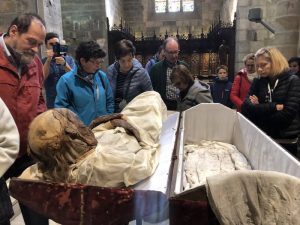The paths I take to finding these facts of the week can be a bit tortuous, winding here and there, but they lead in the most interesting of directions. A few weeks ago, I posted about Inguma, the bringer of nightmares. One way to protect against Inguma is to say a short prayer to Santa Inés. It turns out, Santa Inés is a mummy, the remains of a woman who died in the early 1600s. And she isn’t the only mummy in the Basque Country – there are several. We don’t know the truth about all of them, but several are venerated for their healing powers.

- The best preserved mummy is Inés Ruiz de Otalora, popularly known as Amandre Santa Inés. Her remains lie in Mondragón, where her body was taken after she died in Valladolid in 1607, childless and widowed. She had already been interred for some time and when her remains were excavated to move to Mondragón, it was in an immaculate state, leading people to say it was a sign of her sanctity. People believe that she protects against nightmares and Inguma and insomnia to the point of they pray to her in case they are not able to sleep. In life, she was the fourth daughter of Miguel Ruiz de Otalora, a regent of the Court of Nafarroa.
- The Counts of Durango are actually two mummies that, until 1967, had been interred in Elorrio. However, at that time, one of their heads was stolen so the two bodies were transferred to the Basque Archaeological, Ethnographic and Historical Museum of Bilbao. The bodies were attributed to the first Counts of Durango – Munio Sánchez and his wife Leguncia – who founded the Church of San Agustín de Echevarria in the year 1053. However, their tomb is of a later style, so this identification is uncertain.
- The Gorputz Santue, or Holy Corpse, resides in Errigoiti. It had been found in a niche in the wall of the church when it was renovated in 1550. Legends says that when the townspeople tried to build a new church, the construction supplies kept mysteriously moving to the site of the old church. One night, a group of men stood watch, and saw a virgin driving a cart pulled by two ox that moved the supplies. Thus, she became known as Our Lady of Idibalzaga, Our Lady of the Black Ox (as one of the ox was black). When the body was discovered, legends says that two boys tossed her shoes aside – one was immediately struck blind and the other lost the use of his arm, though both recovered after spending a few days near the body. In reality, the body is that of a man, not a woman.
- San Fausto is preserved in the parish church of Bujanda in Araba. References to San Fausto date as far back as 1547. The Catholic Church has said that the remains are those of San Fausto Labrador, the protector of childbirth and fertility, particularly the fertility of marriages and the land. Legend has he was from Catalonia and was a slave in Africa, before converting his master to Christianity. Upon his death, maybe in 604, he told his friends to put his body on his horse and let it take it where it would, which is how he ended up in Araba. However, whether he actually existed is not clear, and he may be a legendary figure confused with Faust of Córdoba.
- In Labiano, Nafarroa, lies Santa Felicia. Felicia was the daughter of a king of Aquitaine. Her mummy has been mentioned since at least 1650, though it isn’t clear if the mummy is really her. She is said to be able to help against headaches and disorders, as mentally disabled children were brought to her. Chips from her wooden coffin were taken as they were thought to have special properties. Legends says she retired from the world but her brother, Guillermo, killed her when she refused to return with him. As with Fausto, it is said her body was placed on a mule that went where it would, eventually stopping at Labiano.
- Madre Catalina – Mother Catalina – is in a convent in Pamplona/Iruna, Nafarroa. A sixteenth century nun, she died in Barcelona when she was 50 and 7 months later her body was still in a state of incorruptibility. There are no special traditions associated with her as her body is hidden away in the convent.
- The remains of Leonor de Calbo are also preserved in a convent, in Astigarraga, Gipuzkoa. Her almost perfectly preserved body was found when they were digging the foundations of a convent. it is said that the remains are those of Mother Leonor de Calbo, the founder of the convent of San Bartolomé in Donostia where it was discovered in 1325. Most of her remains were subsequently destroyed in a fire in 1813 during the War of Independence, or Peninsular War. The nuns that watch over her say she has cured seriously ill children. If the child wears clothing passed over the body, he or she will either be cured or die within three days.
A full list of all of Buber’s Basque Facts of the Week can be found in the Archive.
Primary sources: Antropologia, historia y creencias populares en torno a las momias conservadas en el Pais Vasco, Francisco Etxeberria, Angel Armendariz, José Angel Barrutiabengoa, Miguel Angel Carnicero, Lourdes Herrasti, Germán Tamayo, José Ignacio Vegas, Cuadernos de Sección. Ciencias Médicas 3, 11 (1994); Estornés Lasa, Bernardo. OTALORA, Inés Ruiz de. Auñamendi Encyclopedia, 2024. Available at: https://aunamendi.eusko-ikaskuntza.eus/en/otalora-ines-ruiz-de/ar-112905/; Una ‘amandre’ de 405 años by Kepa Oliden, El Diaro Vasco; Urzainqui Miqueleiz, Iosune. SANTA FELICIA. Auñamendi Encyclopedia, 2024. Available at: https://aunamendi.eusko-ikaskuntza.eus/en/santa-felicia/ar-126489/



I think that your path is tortuous rather than torturous; that is, winding, and not characterised by pain & suffering.
!!! Indeed. Thanks for catching that!